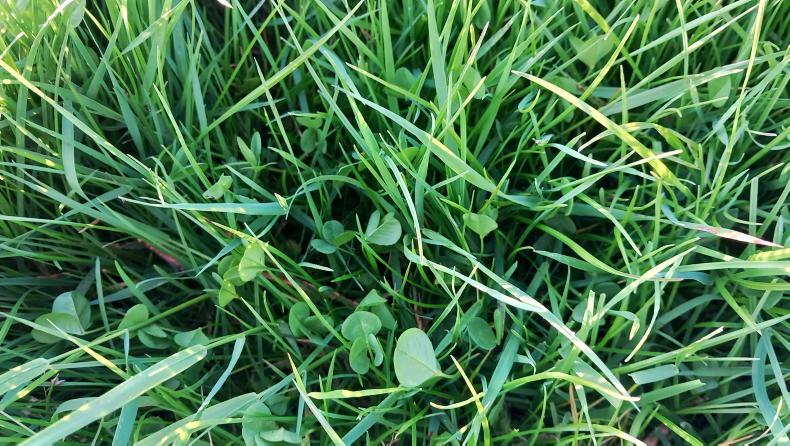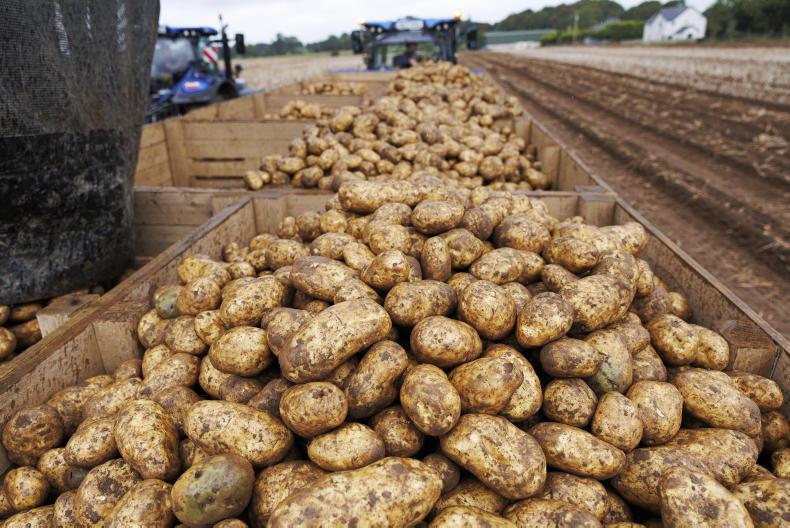Even though a fifth of the land area on Patrick Casement’s farm is planted in trees, his soils still account for almost 93% of the total carbon stored on the farm.
As part of the ARCZero project, carbon stocks on Patrick’s farm near Ballycastle, Co Antrim, were surveyed by soil sampling and LiDAR mapping.
During a farm walk last Wednesday, visitors were told that 924t of carbon is stored in above ground biomass, mainly trees and hedges. A further 175t is estimated to be in roots below the ground.
However, the figures pale in comparison to the 14,906t of carbon that is stored in soils across the 175-acre farm.
“The soils on this farm are light and sandy, so they will hold a lot less carbon than clay or peaty soils which are more common in NI,” Patrick explained.
“We also only sampled soils to a depth of 30cm. Research shows that 30% of total soil carbon can be stored below 30cm so our figures are probably an underestimate,” he added.
Leased
Patrick farmed in his own right for 30 years but in recent times he has been leasing his land out to a neighbouring sheep and suckler farmer.
However, he is still involved in the management of the land and has been applying granular lime to permanent grassland over the last two years to increase soil pH.
“There is now an incredible amount of clover in these fields, even though it has not been reseeded since 1975 and has had no clover stitched in,” Patrick said.

Wild white clover appeared in grass swards soon after granular lime was applied.
“There has been a certain amount of wild white clover in the soil, and it responded immediately to the lime,” he maintained.
Visitors were told that the white clover should fix nitrogen from the air into the soil, which will help reduce chemical fertiliser bills. It will also improve the nutritional content of the sward for livestock and makes soils more suitable for soil biology, such as earthworms.
“It shows the importance of getting soil pH right. The ARCZero farms are all different systems in different conditions but lifting soil pH by applying lime is the one thing we have all been doing,” Patrick said.
Same advice for
improving profits
and carbon
Taking steps to improve a farm’s profitability will also help reduce its carbon footprint, CAFRE adviser Gary Haslem told attendees at the ARCZero event.
“Farm businesses need to remain profitable. Our advice on carbon is the same advice we have been giving to improve financial performance,” he said.
Haslem maintained that between 30% and 40% of emissions on typical livestock farms in NI are attributed to methane from ruminants.
After that, 20-25% of carbon emissions tend to come from livestock feed.
“The emissions from fertiliser varies across farms and manure management is another key source of emissions,” Haslem said.
Net emissions
A key point raised by Professor John Gilliland was that carbon which is removed from the atmosphere and stored in soils, trees and hedgerows needs to be measured and accounted for when calculating a farm’s net greenhouse gas emissions.
He said the proportion of gross emissions on ARCZero farms that has been offset by this process, known as carbon sequestration, varies massively from 26% to 560%.
“The problem with the current system [for calculating emissions] is that it uses one brush to tar all farms,” Gilliland said.
Excess phosphorus stays ‘for
generations’
Soil analysis results showed that two fields on Patrick Casement’s farm had high levels of phosphorus.
One of fields had a rookery in the past and so the high phosphorus index was attributed to the long-term build-up of bird droppings.
The other field includes the ruins of an old church, which was surrounded by settlement in the distant past.
Professor John Gilliland described this as “heritage phosphorus” which comes from waste and remains of animals and of humans.
He said similar soil analysis results were seen near historic sites on Devenish Nutrition’s farm in Dowth, Co Meath. Gilliland pointed out that phosphorus is a significant water quality issue for the NI agriculture industry and suggested it could persist into the long term unless excess phosphorus in soils is used up.
“If a phosphorus index is too high for too long, it will stay there for generations,” he warned.
Even though a fifth of the land area on Patrick Casement’s farm is planted in trees, his soils still account for almost 93% of the total carbon stored on the farm.
As part of the ARCZero project, carbon stocks on Patrick’s farm near Ballycastle, Co Antrim, were surveyed by soil sampling and LiDAR mapping.
During a farm walk last Wednesday, visitors were told that 924t of carbon is stored in above ground biomass, mainly trees and hedges. A further 175t is estimated to be in roots below the ground.
However, the figures pale in comparison to the 14,906t of carbon that is stored in soils across the 175-acre farm.
“The soils on this farm are light and sandy, so they will hold a lot less carbon than clay or peaty soils which are more common in NI,” Patrick explained.
“We also only sampled soils to a depth of 30cm. Research shows that 30% of total soil carbon can be stored below 30cm so our figures are probably an underestimate,” he added.
Leased
Patrick farmed in his own right for 30 years but in recent times he has been leasing his land out to a neighbouring sheep and suckler farmer.
However, he is still involved in the management of the land and has been applying granular lime to permanent grassland over the last two years to increase soil pH.
“There is now an incredible amount of clover in these fields, even though it has not been reseeded since 1975 and has had no clover stitched in,” Patrick said.

Wild white clover appeared in grass swards soon after granular lime was applied.
“There has been a certain amount of wild white clover in the soil, and it responded immediately to the lime,” he maintained.
Visitors were told that the white clover should fix nitrogen from the air into the soil, which will help reduce chemical fertiliser bills. It will also improve the nutritional content of the sward for livestock and makes soils more suitable for soil biology, such as earthworms.
“It shows the importance of getting soil pH right. The ARCZero farms are all different systems in different conditions but lifting soil pH by applying lime is the one thing we have all been doing,” Patrick said.
Same advice for
improving profits
and carbon
Taking steps to improve a farm’s profitability will also help reduce its carbon footprint, CAFRE adviser Gary Haslem told attendees at the ARCZero event.
“Farm businesses need to remain profitable. Our advice on carbon is the same advice we have been giving to improve financial performance,” he said.
Haslem maintained that between 30% and 40% of emissions on typical livestock farms in NI are attributed to methane from ruminants.
After that, 20-25% of carbon emissions tend to come from livestock feed.
“The emissions from fertiliser varies across farms and manure management is another key source of emissions,” Haslem said.
Net emissions
A key point raised by Professor John Gilliland was that carbon which is removed from the atmosphere and stored in soils, trees and hedgerows needs to be measured and accounted for when calculating a farm’s net greenhouse gas emissions.
He said the proportion of gross emissions on ARCZero farms that has been offset by this process, known as carbon sequestration, varies massively from 26% to 560%.
“The problem with the current system [for calculating emissions] is that it uses one brush to tar all farms,” Gilliland said.
Excess phosphorus stays ‘for
generations’
Soil analysis results showed that two fields on Patrick Casement’s farm had high levels of phosphorus.
One of fields had a rookery in the past and so the high phosphorus index was attributed to the long-term build-up of bird droppings.
The other field includes the ruins of an old church, which was surrounded by settlement in the distant past.
Professor John Gilliland described this as “heritage phosphorus” which comes from waste and remains of animals and of humans.
He said similar soil analysis results were seen near historic sites on Devenish Nutrition’s farm in Dowth, Co Meath. Gilliland pointed out that phosphorus is a significant water quality issue for the NI agriculture industry and suggested it could persist into the long term unless excess phosphorus in soils is used up.
“If a phosphorus index is too high for too long, it will stay there for generations,” he warned.










SHARING OPTIONS